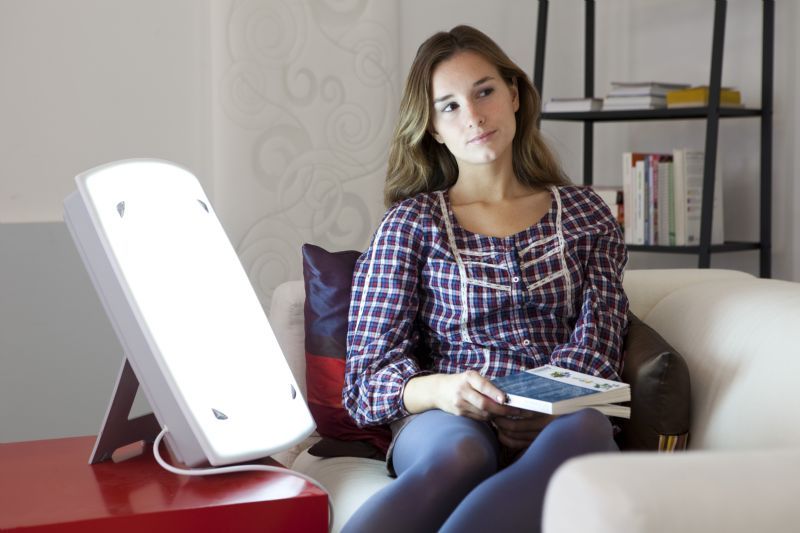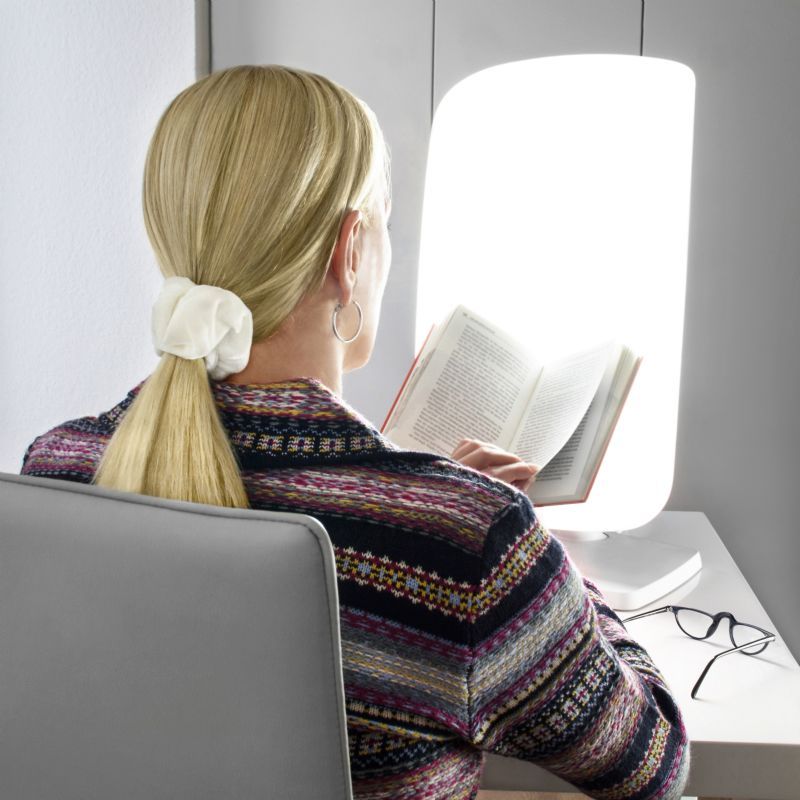 Written by Amanda Lundberg, BSN, RN
Written by Amanda Lundberg, BSN, RN
A light therapy lamp is a specially designed light that is produced to mimic the beneficial effects of sunlight. Also known as SAD lights, bright boxes or bright light therapy lamps, these lights can be used to treat light-related conditions including seasonal affective disorder, insomnia, jet lag and more. According to Mental Health America, in a given year approximately 5% of the US population experiences seasonal depression. As such, it is important that individuals be educated on light therapy and how to choose the most appropriate therapy lamp for their condition.
A light therapy lamp works by mimicking natural daylight and tricking the body into producing hormones which help regulate our mood, energy and sleep-wake cycle. By producing a chemical change in the brain, the lamp can effectively improve mood and sleep, increase energy levels, and ease other symptoms of seasonal affective disorder, winter blues and insomnia. When applied consistently and at the appropriate time, a light therapy lamp can also help reset our circadian rhythm or sleep-wake cycle which directly impacts hormone release, appetite management, and alertness.

Various light therapy lamps have been developed to treat a wide range of light-related conditions. Choosing the right lamp for you is imperative to achieving your goals and maximizing benefits. Medical-Grade lamps are lights designed for those individuals diagnosed with a health condition such as seasonal depression or seasonal affective disorder. They produce optimal results by giving out the maximum amount of light producing 10,000 lux from 12 inches away. They also tend to be larger and simulate direct sunlight exposure with a downward application. Conversely,Wellness-Grade lamps are more appropriate for milder conditions and tend to be smaller and more compact. They can produce 10,000 lux but require closer proximity to the light source and may require increased duration of treatment.
 | Sunlight Therapy Lamp with Large Screen and 4000k Color Temperature | Carex Day-Light Plus View Product |
Conditions That Require A Medical-Grade Lamp: SAD, seasonal depression, sleep disorders, anxiety. Our best lamp is the Carex Day-Light Classic Plus Therapy Lamp.
 | Bright Light Therapy Lamp with Glare-free White Light | TheraLite Mood and Energy Enhancing Lamp View Product |
 | Bright Light Therapy Lamp with 10000 LUX | Carex SunLite by Compass Health View Product |
Conditions That Require A Wellness-Grade Lamp: Milder cases of winter blues, jet lag, those requiring shift work adjustments, individuals looking to mimic sunlight. Our best lamp is the TheraLite Mood and Energy Enhancing Light.
Lux is a measure of the intensity of light and is an important consideration when purchasing a therapy lamp. For a light therapy lamp to be most effective in the treatment of SAD, winter blues, insomnia, or depression, it is recommended that it emit approximately 10,000 lux, which is much brighter than the standard indoor lighting. Most lamps tend to have 1-4 brightness settings which can be adjusted according to individual tolerance and treatment goals. Dimmer settings will require increased treatment duration to achieve desired effects. For those with light sensitivities, considering a light therapy lamp with multiple settings would be most appropriate.
Color temperature is a measure of warmth or coolness of a light and is measured in Kelvin (K). Cool blue color lights tend to promote alertness and energy but too much can result in excess cortisol release (measured around 10,000 K). Warmer lights mimic sunrise or sunset and tend to promote relaxation and stress reduction (rated around 1,000 K). White light is often used in office settings and promotes a calm and productive mind (which is in the 5,000 to 7,000K range). In general, those with light-related conditions tend to benefit most from a light that replicates cool daylight around the 5000-6000 Kelvin range.
When choosing the right light therapy lamp for you, it’s important to find a product that will facilitate consistent use. Effectiveness of the treatment is directly correlated to regular application, therefore consider your individual goals and setup. Light therapy lamps can vary in size and shape and offer different features. Medical grade lamps tend to be larger and less mobile whereas others are small, portable and more appropriate for those planning to travel during the winter season. Assess your home setup and lifestyle, identify your goals, and make your purchase with the confidence you deserve.

There have been no harmful effects identified of light box therapy on the eyes however, long term studies have not been performed. For an efficient treatment, your eyes should remain open throughout the applied timeframe. The light box should be pointed at an upward or downward angle, so you are not directly looking into the light. Many light boxes are specially designed to filter out all or most of the UV light to avoid eye damage. It is important that the device you purchase filters out UV light as this light form can cause damage with prolonged exposure to the eyes. If you have certain eye problems such as cataracts or glaucoma, speak to your eye specialist to discuss appropriate treatment options.
Yes, light therapy is safe and effective when used properly. Ensure proper filtration of UV light to protect the eyes and use each product according to the manufacturer’s instructions for optimal outcomes.
Benefits of light therapy can be seen within a few days, with notable symptom reduction often observed within a few weeks. Many individuals continue the treatment throughout the winter. If symptoms are not improving after 2-3 weeks, increase duration of treatment or contact your physician to discuss alternative treatment options.
Upon waking, initiate treatment by placing the light therapy lamp on a counter or table. Sit comfortably and follow the manufacturer’s instructions regarding the correct distance from the lamp, as this can vary from product to product (usually 10 to 12 inches away). Keep eyes open but do not stare directly into the light. For optimal effects, place the lamp slightly above you and tilt downward at a 15 degree angle so the light beams down into your face mimicking natural sunlight. Usually, light therapy lamps are placed at your 2 o’clock or 10 o’clock.
Light therapy should be performed shortly after waking, ideally between 6 AM and 9 AM. Light therapy kickstarts your brain into thinking it is morning-time, so that is why it is important to use your light box only in the morning. For the treatment of light-related conditions, the light source should produce 10,000+ lux with treatment initially applied for 10-15 minutes and building up to 45-60 minutes.
Although the direct cause is unclear, research has suggested that exposure to bright light helps reduce seasonal affective disorder symptoms by regulating the hormones serotonin and melatonin in the body thereby resetting the circadian rhythm and improving overall mood and energy levels.
Light therapy lamps work to restore a natural circadian rhythm within the body. Your circadian rhythm helps regulate your internal clock and contributes to alertness during the day and restfullness at night. In the case of insomnia, your sleep-wake cycle may be disrupted due to interference of the circadian rhythm. With proper use of the light therapy lamp, you can help restore natural circadian rhythm and improve overall sleep quality, thereby reducing insomnia.
No, seasonal affective disorder or SAD is different from the winter blues and is characterized by a more severe condition involving two or more weeks of a depressed state. Symptoms of SAD can include reduced motivation, energy, sleep disturbance, and increased appetite. SAD is a major depressive disorder that requires diagnosis and treatment.
When it comes to choosing the best therapy lamp for you or your loved one, multiple considerations must be taken into account including quality of the lamp, condition being treated, and appropriate use. If a light-related condition, insomnia or jet lag is affecting your life, consider purchasing a light therapy lamp today.
If you are interested in browsing similar products, check out our Light Therapy devices for sale. For more helpful information including caregiving tips and buying guides check out our blog, Caregiver University.

Amanda is a registered nurse with over a decade of experience in hospital, clinic, and healthcare management settings. Her primary focus has been collaborating with patients to manage disease processes. Aiming at continuing active lifestyles for her patients, Amanda has become an expert in adjunct therapies.
Amanda incorporates a holistic approach to heal the body from within. She has completed extensive research in remedial treatments using oxygen, as well as becoming a professional light therapy specialist. Her reparative ethos to health has sparked engaging conversations and teaching opportunities nationwide.
Amanda has taken her passion for articulating technical medical language and transitioned to freelance writing. She enjoys bringing a clinical voice to health and wellness brands.